Child Interaction with Playground Surfacing Focus Groups
Focus Groups
Crumb Rubber Study_GenericClearance - 10.16.2016
Child Interaction with Playground Surfacing Focus Groups
OMB: 3041-0136
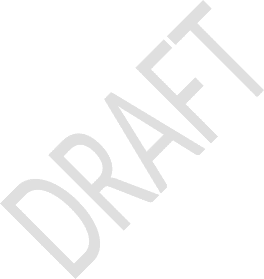

TITLE OF INFORMATION COLLECTION: Child Interaction with Playground Surfacing Focus Groups
OBJECTIVE:
The objective of this project is to provide the U.S. Consumer Product Safety Commission (CPSC) with data regarding toddlers’ interaction with playground surfacing material. Playground surfaces derived from recycled tires are a popular option, due to their low maintenance, variety of colors and designs, and ability to attenuate mechanical impacts from falls. However, there is recent public concern that the chemicals in surfaces derived from recycled tires may be hazardous to human health.
The planned focus groups will include open discussions in which parents, caregivers, and recreational facility (i.e., playground) employees can speak of toddlers’ interaction with the playground surfacing materials. Topics to be studied include supervision, how children are using playground equipment, including new designs; and age-appropriate design. The data will enable the CPSC to estimate exposure/risk and make recommendations regarding playground surfaces derived from recycled tires.
BACKGROUND:
The public, media, and government agencies have expressed concern about the safety of recreational surfaces derived from recycled tires. In February 2016, the Federal Action Plan on Recycled Tire Crumb Used on Playing Fields and Playgrounds was announced. This is a multi-agency effort including the U.S. Environmental Protection Agency (EPA), Centers for Disease Control and Prevention (CDC), and CPSC to perform research that will improve the understanding of potential health effects of recreational exposures to recycled tires. The US EPA and CDC are studying the chemical characteristics of recycled tire materials and the exposures on athletic fields. The CPSC is tasked with studying exposures of children to playground surfaces derived from recycled tires. The proposed focus groups are intended to gather data from a small sample of parents, childcare providers, and personnel responsible for the inspection and maintenance of playgrounds on their experiences and observations of how children interact with various types of playground surfaces, including those derived from recycled tires.
DESCRIPTION OF RESPONDENTS:
The recruitment goal is to identify 30 participants. Participants will include:
10 parents, family members, or in-home caregivers who supervise at least one child age 1or 2 years old in playgrounds on a regular basis (i.e., three times a week or more).
10 childcare providers who supervise at least one child age 1 or 2 years old in playgrounds on a regular basis (i.e., three times a week or more).
10 parks and recreational facility employees who inspect and maintain playgrounds on a regular basis (i.e., once a month or more) with current Certified Playground Safety Inspector (“CPSI”) certification. For recruitment and verification purposes, a list of current CPSI holders is available at: http://www.nrpa.org/CPSI_registry/.
The contractor will attempt to recruit an accurate representation of the U.S. population and to include a range of demographic and socioeconomic groups. Participants will be carefully selected, targeting individuals representing the conditions outlined above.
BURDEN HOURS
Category of Respondent |
No. of Respondents |
Participation Time |
Burden |
Focus Group Participants |
30 |
150 minutes per participant |
75 hours |
Totals |
30 |
150 minutes per participant |
75 hours |
FEDERAL COST: The estimated annual cost to the federal government is $22,163.
Total estimated cost to the government for conducting the data collection is as follows:
Number of Participants 30
Total estimated cost of conducting focus group $22,163
Cost per completed Participant includes $125-150 stipend $737.77
This estimate is based on the total cost of the awarded research contract, divided by the specified number of completed participants.
Focus Group on Child Interaction with Playground Material
Moderator Guide
Moderator’s Instructions:
This guide will be used to steer discussion to the topic areas to be covered, and the specific questions of interest within each topic area. The moderator does not need to ask the questions exactly as worded here. Focus group discussions are more like a conversation than a set of structured questions. The discussions should be as informal as possible, and participants should be encouraged to speak openly and freely. The moderator will also need to make sure that all participants in the group have an opportunity to express their opinions. Because each group of participants may be different, a responsive and flexible approach should be used for the focus group discussion.
Before You Come to the Focus Group
Thank you for participating in this important research—we’re looking forward to talking with you soon. There is one thing we would like you to do before you come to participate in the focus group.
Please take a picture of the playground surface at the playground that you visit most regularly, and email it to us at: [email protected]. If you regularly visit more than one playground, feel free to send multiple pictures!
Review Purpose, Objective, and Scope of the Focus Group
Moderator introduces self and aides
The purpose of this focus group is for us to learn about your experiences with playgrounds. You have been selected to participate in this focus group because you indicated that you are a parent, caregiver, or recreational facility employee who meets the conditions stated in the application.
How many of you have taken part in a focus group?
Before we begin our discussion, I would like to review some ground rules:
No one will be judging your responses.
We want you to do the talking.
There is no right or wrong answer.
Everyone's experiences and opinions are important.
We would like to make sure everyone participates. I may call on you if I haven’t heard from you in a while.
My role as moderator will be to guide the discussion.
We are recording this session.
You are free to leave at any time. If you would like to leave, please inform the moderator or an aid.
Refreshments, rest rooms, and breaks are available and planned. Please be completely honest during this discussion. Your full name will not be used in any reports that we prepare about the focus group.
What is said in this room stays here.
Introductions
Parents/Caregivers
Go around to each person in turn. Initiate a round of introductions with participants (first names only), and ask each participant how many kids they watch and the age(s) of the child(ren).
Recreational Facility Employees
Go around to each person in turn. Initiate a round of introductions with participants (first names only), and ask each participant what type of playgrounds they maintain/inspect.
Discussion
Parent/Caregiver Questions
What time of year do you go to the playground? Does the frequency of your visits to the playground change throughout the year? Does the type of playground you go to change throughout the year?
On an individual day, what factors do you consider before deciding to go to the playground (e.g., too hot, raining)? Are any of these factors specific to the playground surface (e.g., surface is too slick when wet, surface smells on very hot days, water pooling)?
What age did your child start playing in the playground? At what age did they play on the playground surface? At what age did they use the equipment? Swings? Slides?
How often does your child fall at the playground? During what activities?
How do you typically interact with your child while they are playing? How has this changed as your children have gotten older?
Do your children wear shoes while playing? What kind of shoes? Does your child take their shoes off while playing?
Do your children wear shorts and t-shirts to the playground? How often throughout the year?
Does your child eat/drink at the playground?
Does your child use a pacifier at the playground?
Let’s talk a little more about playground surfaces now. I know that you all sent us photos of the surfaces of some of your playgrounds, and here are some of those.
Now let’s also look at some other examples of surfacing material:
[Use flashcards with pictures of different playgrounds and playground equipment that use recycled tires as the primary surfacing material and other common surfacing material listed below. Provide samples of recycled tire material, if available. Label flashcards and samples with name of material.]
Wood mulch/Engineered wood fiber
Loose rubber mulch or chips
Bonded rubber (large rubber chunks or shreds bound in the surface)
Smooth continuous rubber, poured in
Rubber tiles
Other
[Have participants raise hands if their children have ever played on each surface type (record number). Instruct participants to use labeled terms for referring to surface types during the focus group discussion.]
What things do you like about the surfacing material? What are the things you dislike?
Type and frequency of exposure during an individual visit
For solid surface playgrounds (smooth continuous rubber, rubber tiles), what are the activities that take place on the playground and playground surface? [Have group generate and rank order (or group) activities. Write the participant responses on board while group is generating ideas; then get consensus info. on most common activities. Probe examples of specific interactions of interest: running, crawling, sliding, swinging, climbing, turning, jumping].
Which of these activities result in the most contact/interaction with the surface?
How often do you see children fall onto the surface? During what activities?
Do children play with toys on this type of surface? What type of toys? How do they play?
For loose fill playgrounds (wood mulch/engineered wood fiber, loose rubber mulch or chips, bonded rubber), do you generally observe the same activities on this surface type? [If not, brainstorm activity types, rank order.]
Which of these activities result in the most contact/interaction with the surface? What is the nature of this contact?
Describe the ways children play with and interact with the material. [Probe examples of specific interactions of interest: playing with material, games with surface material (e.g., snowball fight), toys in surface material, digging, transporting, eating]
Do children play with toys in/on this type of surface? What type of toys? How do they play?
Have you seen your child or any other child put surface material in their mouth? If so, how often? What were they doing with the material? Do parents tend to remove the surface material quickly?
Have you ever found rubber particles after playing at a playground in your child’s hair, clothes, shoes, or lint after washing clothes? In house, in car, on toys? How about wood mulch?
Have you found staining/dust on clothes, skin (including mouth, nose, cuts/scrapes), or toys from playground surfacing material? Are there any other types of contact with the playground surface that haven’t been addressed?
What percentage of the overall time at the playground is devoted to activities on the playground surface as opposed to on equipment?
Do you wash your child’s hands after going to the playground/before eating?
Do you bathe your children after going to the playground? How soon after going?
Do you wash toys after they are used at the playground?
Equipment Usage
[Show picture of manufacturer age label (sticker), and a stand-alone sign with rules and age recommendations] Have you seen these age recommendation labels on your playground? Have you seen this sign with rules and age recommendations?
Do the age labels influence what equipment you allow your child to use?
[Show pictures of equipment] What types of equipment do your children play on?
What are your child’s favorite equipment?
Do your children enjoy playing on this equipment? What is their favorite new equipment? Why? What is your least favorite new equipment? Why?
Age, age appropriate equipment and the influence of age on play
What ages of children do you see at the park? Youngest to oldest?
What are the differences in how children interact with the equipment based on age?
[Show picture of manufacturer age label (sticker), and a stand-alone sign with rules and age recommendations]
Do you see other parents following the stated age recommendations and other rules?
Playground equipment
How long does your child spend on each type of equipment [have the group agree on most popular activities (in terms of how long is spent on equipment)]
[Show pictures of new equipment] Have you seen any of these examples of new playground equipment in your playground?
What equipment do you tend to see the most children at?
Are they using the equipment properly, as designed?
[Show label with strangulation hazard label]. Do you see other parents following the guidance in this warning?
Supervision
How do the other caregivers you see at the park interact with their children?
In your opinion, are children being properly supervised, for their age?
If not, what stands in the way of proper supervision?
Do other parents tend to keep their children within their line of sight?
How often do you see other parents distracted or looking away from their child?
What is distracting them?
General Questions
[Ask these questions only if not captured in earlier discussion]
Do you have any concerns about any type of playground equipment?
Do you have any concerns about any type of surfacing materials?
Recreational Facility Employee Questions
How many playgrounds do you maintain and / or inspect?
Are you assigned to specific playgrounds or do multiple people have responsibility for playgrounds?
How large a geographic area are you responsible for?
Identify the state where you work and describe its climate.
How often do you maintain playgrounds? How often do you inspect playgrounds?
Maintenance and inspection needs and issues
What do you look for in your inspections/when you are maintaining playgrounds? What factors go into how frequently playgrounds are maintained and/or inspected?
Are there special circumstances that increase the frequency of maintenance or inspection?
What problems with equipment or playground surface or other events would cause you to close the playground? Are any of these specific to a surface material?
Age appropriate equipment and the influence of age on play
[Show picture of manufacturer age label (sticker), and a stand-alone sign with rules and age recommendations] Have you seen these age recommendation labels on the playgrounds you maintain? Or this sign with rules and age recommendations?
Playground equipment
[Show pictures of new equipment] Have you seen any of these examples of new playground equipment in your playground? What is your opinion of this equipment?
How does new equipment affect maintenance/inspection needs?
Selection of surface material and opinions on surface material
Do you provide any input on what types of surface material will be installed?
What are your preferred surface materials? Why?
Does surfacing material depend on climate? Are there certain areas where material types would be preferred/unwanted?
Are you satisfied with the surfacing material at the playgrounds you inspect and/maintain?
Have you encountered any problems or safety concerns with the surfacing material?
If yes, what are the specific concerns?
If you were not a recreational facility employee, would you feel the same, or differently?
Surfacing
[name specific surface type] Are there specific things you look for related to this surface type? Are there maintenance needs/issues specific to this surface type? [generate list, identify group consensus on most common]
What are maintenance solutions to these common needs/issues?
[move on to next surface type] Are the needs/issues the same for this surface type? [if not, generate new list]
Are you assigned to a specific playground or do multiple people have responsibility for one playground?
For loose-fill surfacing only, how do you account for heavy use? How often do you maintain surfacing that has been displaced by weather, children? How often do you refill or replace? Do you use rubber mats?
Injuries/Safety Issues
What are the most common injuries to children that are reported? When you hear about an incident, what is the process for handing the incident? [Examples: report to manufacturer, internal reporting system].
What type of play/injuries would influence you to modify, remove, or replace equipment?
Have you observed any play on equipment or surface material that concerns you? Do you have any suggestions for how to address these issues?
Do you think safety requirements are strict enough? Why or why not?
Wrap-Up
Thank you for your time. What we have heard and learned today will help us understand better toddlers’ interaction with playground surfacing material and equipment.
If you do have any questions about playground surfaces or any safety concerns, I have some information from the Consumer Product Safety Commission here that you are welcome to take with you.
Instruct participants about how they will be reimbursed for their time.
Recruitment Material for Parents and Caregivers
Seeking Parents/Caregivers of Toddlers for a Study on Playgrounds
Fors Marsh Group is looking for participants for a focus group on how toddlers interact with playground surface material. We are looking for parents or guardians who supervise at least one child age 1 or 2 years old in playgrounds on a regular basis
The group will take place at our office located at 1010 North Glebe Rd., Suite 510, Arlington, Virginia (near the Ballston-MU Metro station). Participants will be compensated $125 for participating.
If you are interested, please email us at: [email protected]
Recruitment Material for Child Care Providers
Seeking Child Care Providers of Toddlers for a Study on Playgrounds
Fors Marsh Group is looking for participants for a focus group on how toddlers interact with playground surface material. We are looking for people who work at daycare centers, pre-schools, or otherwise supervise children age 1 or 2 years old in playgrounds on a regular basis.
The group will take place at our office located at 1010 North Glebe Rd., Suite 510, Arlington, VA (near the Ballston-MU Metro station). Participants will be compensated $125 for participating.
If you are interested, please email us at: [email protected]
Recruitment Material for Playground Inspectors
Seeking Playground Inspectors/Employees for a Study on Playground Materials
Fors Marsh Group is looking for participants for focus group on how toddlers interact with playground surface material. We are looking for Certified Playground Safety Inspectors (CPSIs) who inspect and/or maintain playgrounds at least once a month.
The group will take place at our office located at 1010 North Glebe Rd., Suite 510, Arlington, Virginia (near the Ballston-MU Metro station). Participants will be compensated $150 for participating.
If you are interested, please email us at: [email protected]
Focus Group on Child Interaction with Playground Surfacing Material
Recruitment Script and Screening Guide
Date: ______________________ (will be automatically date and time-stamped via Web survey)
Fors Marsh Group is going to be conducting focus groups for the federal government, specifically for the Consumer Product Safety Commission (CPSC). We are trying to understand how toddlers interact with play equipment and surfacing material used in playgrounds. No special knowledge or ability is required to participate. The focus group will take about 1.5 hours and will take place at our office located at 1010 North Glebe Rd., Suite 510, Arlington, Virginia (near the Ballston-MU Metro station).
If selected, you will be paid $125/150 for your participation, upon session completion.
We will not be scheduling you for a focus group today. We need to recruit a number of available people before we try to schedule a session. If you are eligible, we will add your name to the list of potential participants.
Screening Questions
If you are interested, I will need to ask you a few questions to determine your eligibility. Are you interested in participating?
YES [if yes, go to question 1]
NO [if no, end screening]
Are you a parent or caregiver who supervises at least one child who is 1 or 2 years old in playgrounds three times a week or more?
YES [if yes, skip to question 3]
NO [if no, go to question 2]
Are you a recreational facility (i.e. playground) employee who inspects and maintains playgrounds on a regular basis (i.e., once a month or more) and has a current Certified Playground Safety Inspector (CPSI) certification?
YES [if yes, skip to question 4]
NO [if no, end screening]
Questions specific to parents and childcare providers
How many children age 1 or 2 do you supervise? _____
What are their ages? ____________________________________
In general, when the weather is acceptable, how many times per week do you visit a playground? _____
How long do you typically stay at the playground? _________
[For online screening] Below are examples of different playground surfacing materials. If you observe this type of playground surfacing material in the playgrounds you visit, please mark the box below the picture. Please check all that apply. [A photo of each example surfacing material will be included on the website to help participants identify the type of surfacing material]
Wood Mulch or Engineered Wood Fiber: Loose-fill made of shredded or cut wood, similar to wood garden mulch. It may be natural color or dyed for color.
Rubber Mulch or Recycled Tire Loose Fill: Loose-fill similar to wood mulch but made of rubber from shredded tires. It may be black or dyed for color.
Bonded Rubber, Smooth Continuous Rubber (Poured-in-place or EPDM), or Rubber Tiles:
Bonded Rubber: Mulch-sized pieces of rubber bound into a continuous surface that may be porous. The rubber pieces may be black or dyed for color. The rubber pieces are bound to the surface and are not meant to be separated (this differentiates bonded rubber from loose fill rubber mulch).
Smooth Continuous Rubber (Poured-in-place or EPDM): Smooth rubber surface, may be solid color or speckled. Colors can be used to make patterns or designs. The very small crumb-sized rubber pieces are bound to the surface and are not meant to be separated.
Rubber Tiles: Smooth rubber surface made of tiles with obvious seams between individual tiles. They may be colored to make patterns or designs. The rubber tiles on playgrounds are most commonly square, but they also come in other shapes.
Other
--- [end of parent and childcare provider-specific questions, skip to question 14] ---
Questions specific to recreational facility employees
Besides CPSI, do you have other playground safety training or certifications?
YES [list] _____________________________________
NO
How long have you worked as a playground maintainer/inspector? _____________
How often (must be one month or more) do you inspect or maintain playgrounds? _______
[For online screening] Below are examples of different playground surfacing materials. If you have this type of playground surfacing material in the playgrounds you maintain/inspect, please mark the box below the picture. Please check all that apply. [A photo of each example surfacing material will be included on the website to help participants identify the type of surfacing material]
Wood Mulch or Engineered Wood Fiber: Loose-fill made of shredded or cut wood, similar to wood garden mulch. It may be natural color or dyed for color.
Rubber Mulch or Recycled Tire Loose Fill: Loose-fill similar to wood mulch but made of rubber from shredded tires. It may be black or dyed for color.
Bonded Rubber, Smooth Continuous Rubber (Poured-in-place or EPDM), or Rubber Tiles:
Bonded Rubber: Mulch-sized pieces of rubber bound into a continuous surface that may be porous. The rubber pieces may be black or dyed for color. The rubber pieces are bound to the surface and are not meant to be separated (this differentiates bonded rubber from loose fill rubber mulch).
Smooth Continuous Rubber (Poured-in-place or EPDM): Smooth rubber surface, may be solid color or speckled. Colors can be used to make patterns or designs. The very small crumb-sized rubber pieces are bound to the surface and are not meant to be separated.
Rubber Tiles: Smooth rubber surface made of tiles with obvious seams between individual tiles. They may be colored to make patterns or designs. The rubber tiles on playgrounds are most commonly square, but they also come in other shapes.
Other
How old are the playgrounds you maintain/inspect? _______
Are you responsible for any playground equipment or material that has been installed in the past two years?
YES [list type] _____________________________________
NO
--- [end of maintenance worker-specific questions, go to question 14] ---
Please provide your name (first name only is fine): _________________________.
Please provide a phone number where we can easily contact you if you are selected for the study: ______________________________________________________.
Please provide a valid email address where you can be reached if you are selected for the study: ______________________________________________________________.
What is your gender?
Male
Female
Which of one of the following categories best describes your age?
18-25
26-35
36-45
46-55
56-65
66-75
76+
Could you please tell me your race?
White/Caucasian
Black/African-American
Hispanic/Latino
Asian
Middle Eastern
American Indian or Alaska Native
Native Hawaiian or Pacific Islander
Other * SPECIFY *
Don’t know
Prefer not to answer
Please tell me which one of the following categories best represents your total family income?
Less than $10,000
$10,000-$14,999
$15,000-$24,999
$25,000-$34,999
$35,000-$49,999
$50,000-$74,999
$75,000-$99,999
$100,000-$149,999
$150,000-$199,999
$200,000+
Don’t know
Prefer not to answer
How did you hear about the study?
Newspaper
Friend
Email
Craig’s List
Flyer
Other ___________________________
Can you tell me which days and times of the week when you might be available, if you are selected to participate? [Include specific dates/times if possible]
Monday, times: _______________________
Tuesday, times: _______________________
Wednesday, times: _______________________
Thursday, times: _______________________
Friday, times: _______________________
Saturday, times: _______________________
Sunday, times: ______________________
Closing:
Thank you for your time and interest. Once we get enough potential participants, we will schedule the focus group. We cannot guarantee that you will be included because participation depends on several factors. However we will make every effort to include you.
Consent to Participate in a Focus Group
Title of the Project: Child Interaction with Playground Surfacing
Researcher: Fors Marsh Group under contract with the U.S. Consumer Product Safety Commission (CPSC)
Invitation to Participate in a Research Study
Fors Marsh Group invites you to be part of a focus group to investigate how children interact with playground surfaces. The study is funded by the CPSC.
Description of Your Involvement
If you agree to be part of the research study, you will be asked to participate in a focus group where you will discuss your observations regarding playground equipment and playground surfacing material.
The entire session will take about 90 minutes.
Benefits of Participation
Although you may not directly benefit from being in this study, others may benefit because the findings of this study may be used to improve playground equipment and surfacing material.
Risks and Discomforts of Participation
We do not believe that there are any risks or discomforts from participating in this research.
Compensation for Participation
You will be given an incentive of $XX to participate in the group. You will be expected to pay for your own transportation to the facility.
Confidentiality
The results of this study may be published or made public. You will not be identified by full name or pictures/video in any publically released documents or presentations.
There are some reasons why people other than Fors Marsh researchers may need to see information that you provided as part of the study, including audio/visual recordings of your participation. This includes personnel at the CPSC, which is sponsoring the study.
To keep your information safe, your name will not be attached to any data, but a study number will be used instead.
Please be advised that although the researchers will take every precaution to maintain confidentiality, the nature of focus groups prevents the researchers from guaranteeing confidentiality. Please respect the privacy of your fellow participants and do not repeat what is said in the focus group to others.
Voluntary Nature of the Study
Participating in this study is completely voluntary. Even if you decide to participate now, you may change your mind and stop at any time. You do not have to answer any question that you do not want to answer.
Audio/Visual Recording
Audio/visual recording will be done as part of the study procedures. These recordings will be used to collect data but will not be publically released.
You may not participate in this study if you are not willing to be recorded.
Please sign below if you are willing to be recorded.
Storage and Future Use of Data
The researchers will destroy any information containing identifying information about you within six months after completion of the study.
Audio/visual recordings will be archived for potential use for the purposes described above.
Contact Information for the Study Team
If you have any questions about this study, please contact:
Fors Marsh Group
1010 North Glebe Rd., Suite 510
Arlington, VA 22201
Contact Information for Questions about Your Rights as a Research Participant
If you have questions about your rights as a research participant, or wish to obtain information, ask questions or discuss any concerns about this study with someone other than the researchers, please contact Fors Marsh Group at [email protected]. Please send a message with your full name and the name of the study, “Child Interaction with Playground Surfacing Focus Group.” Someone will return your message as soon as possible.
Consent
By signing below, you are agreeing to be in the study, and you are giving permission to be recorded. You will be given a copy of this document for your records, and one copy will be kept with the study records.
Be sure that any questions you have about the study have been answered and that you understand what you are being asked to do. You may contact the researcher if you think of a question later.
I agree to participate in the study. Yes No
_________________________________________________
Printed Name
_________________________________________________
Signature Date
I agree to be audio/video recorded. Yes No
_________________________________________________
Printed Name
_________________________________________________
Signature Date
Appendix A. Examples of the Types of Playground Surfaces for the Focus Groups
Wood Mulch or Engineered Wood Fiber
Description: Loose-fill made of shredded or cut wood, similar to wood garden mulch. It may be natural color or dyed for color.
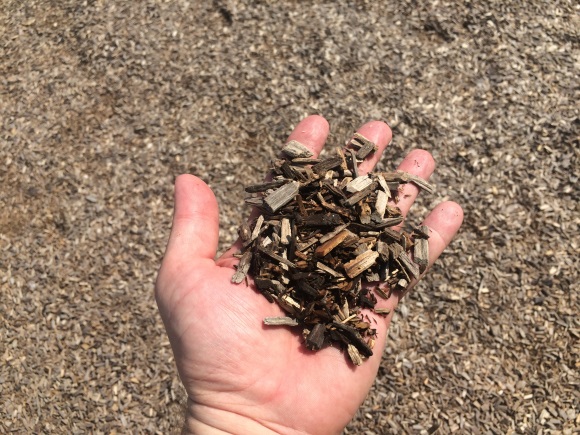
Rubber Mulch or Recycled Tire Loose Fill
Description: Loose-fill similar to wood mulch but made of rubber from shredded tires. It may be black or dyed for color.
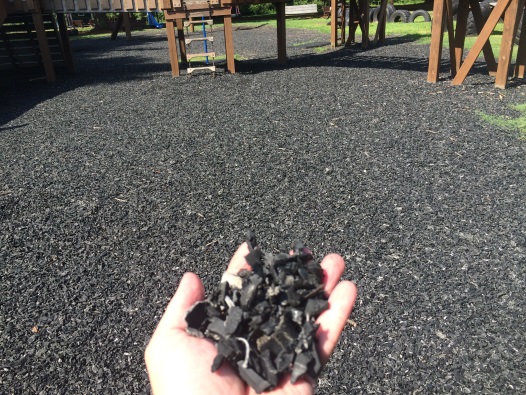
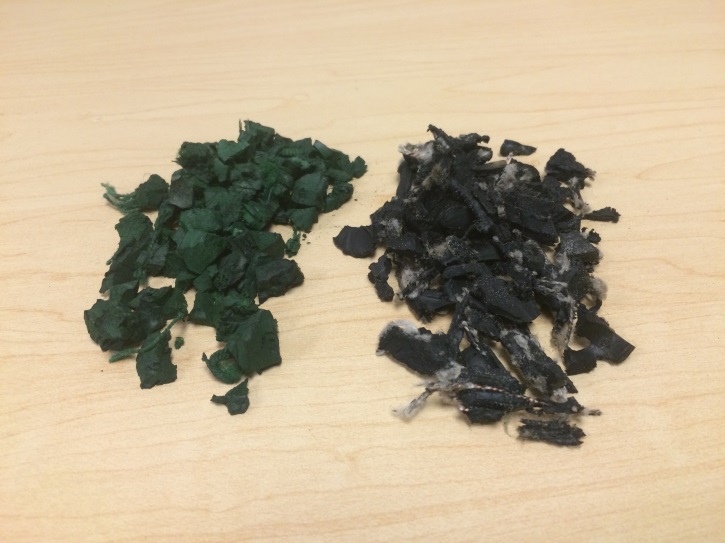
Description: Mulch-sized pieces of rubber bound into a continuous surface that may be porous. The rubber pieces may be black or dyed for color. The rubber pieces are bound to the surface and are not meant to be separated (this differentiates bonded rubber from loose fill rubber mulch), although some pieces may become loose with age and wear.
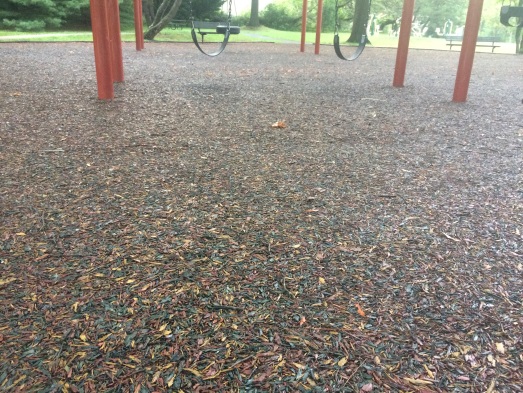
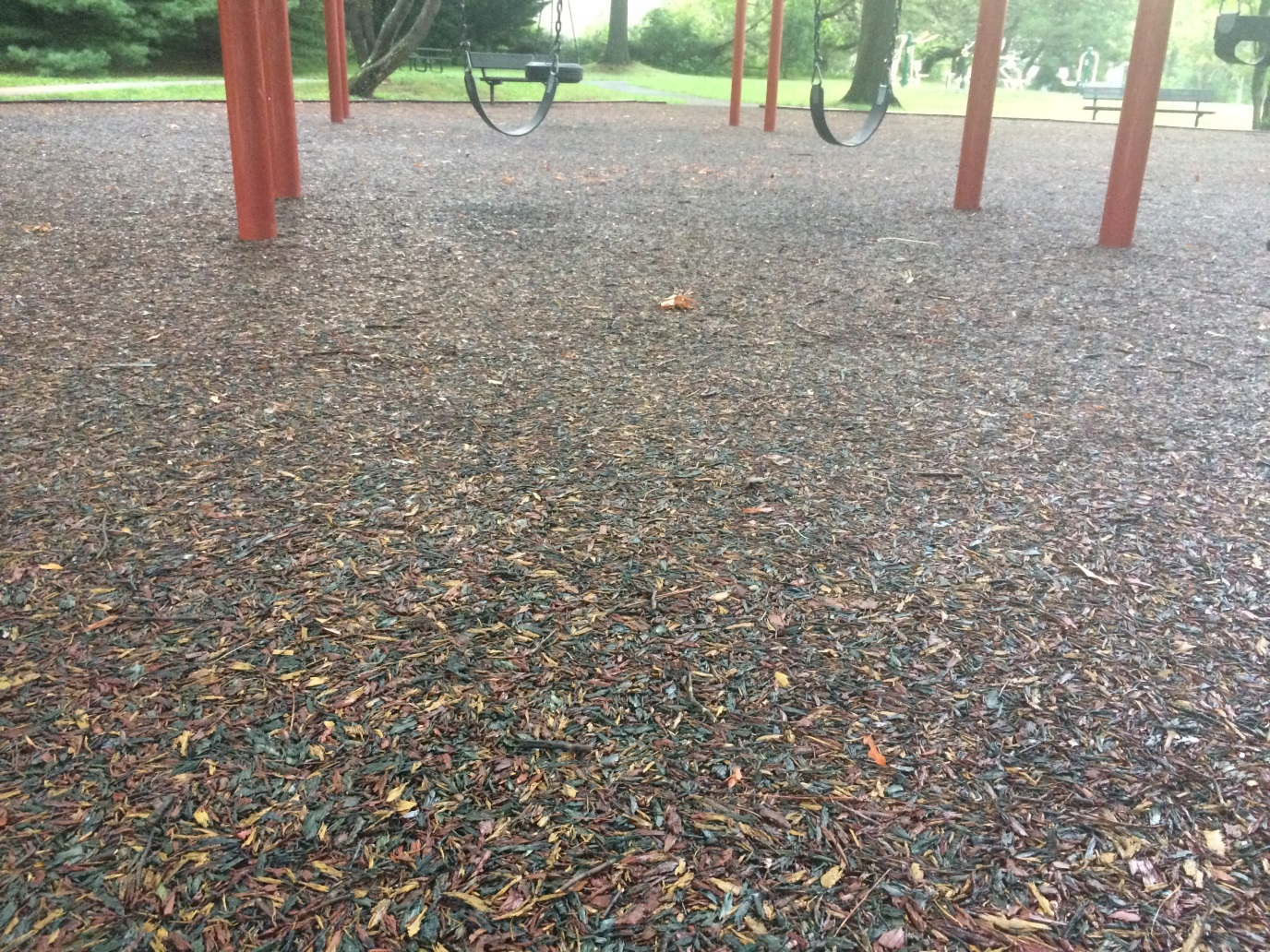
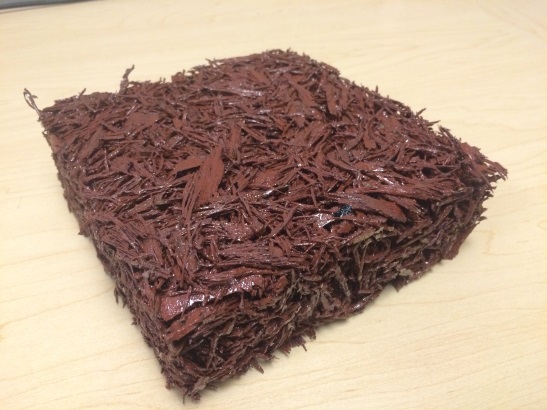
Smooth Continuous Rubber (Poured-in-place or EPDM)
Description: Smooth rubber surface, may be solid color or speckled. Colors can be used to make patterns or designs. The very small crumb-sized rubber pieces are bound to the surface and are not meant to be separated.
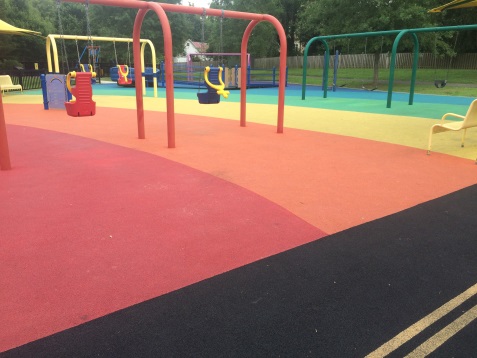
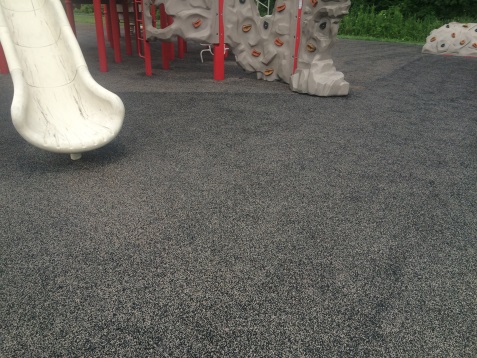
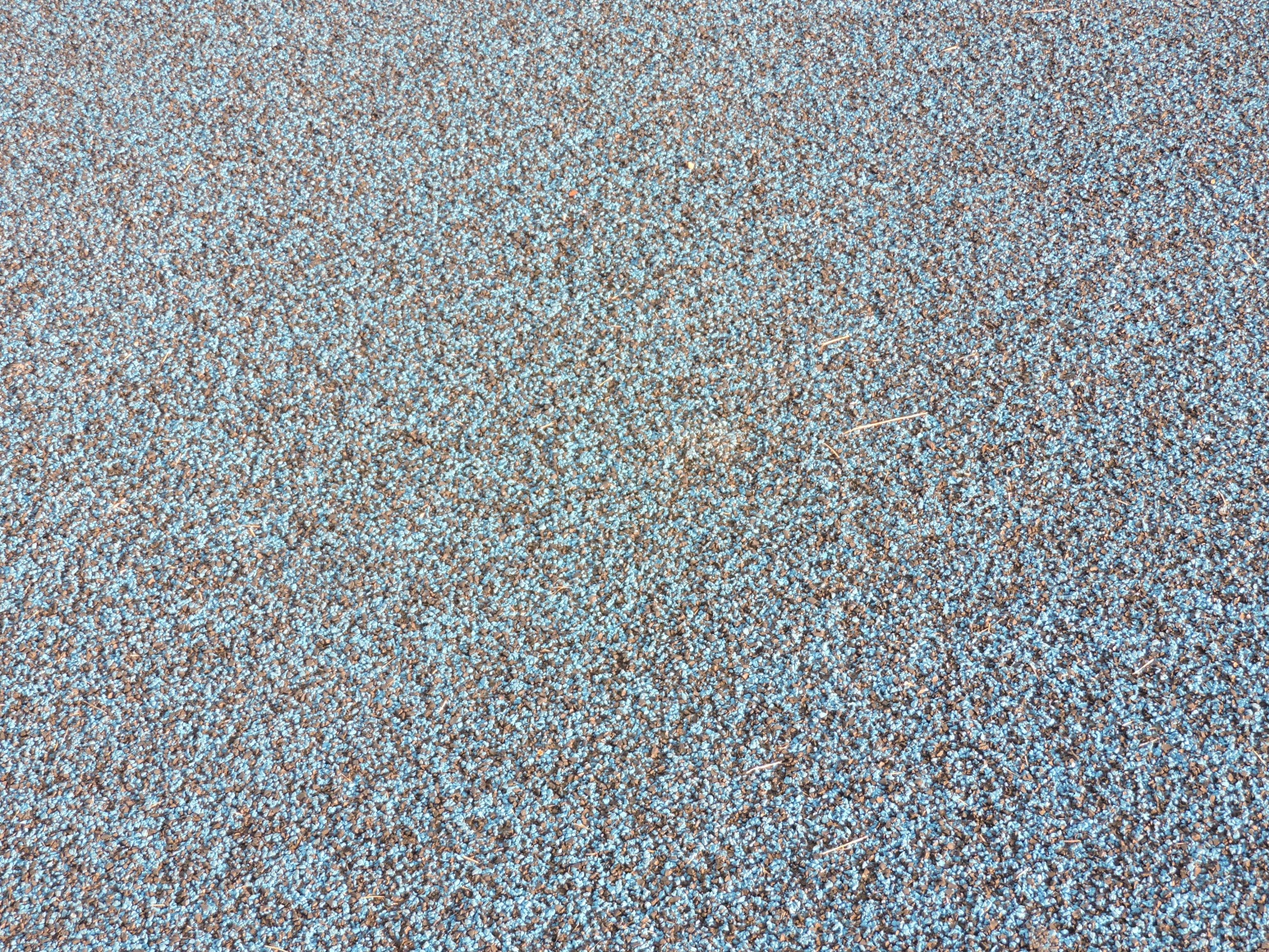
Rubber Tiles
Description: Smooth rubber surface made of tiles with obvious seams between individual tiles. They may be colored to make patterns or designs. The rubber tiles on playgrounds are most commonly square, but they also come in other shapes (not shown).
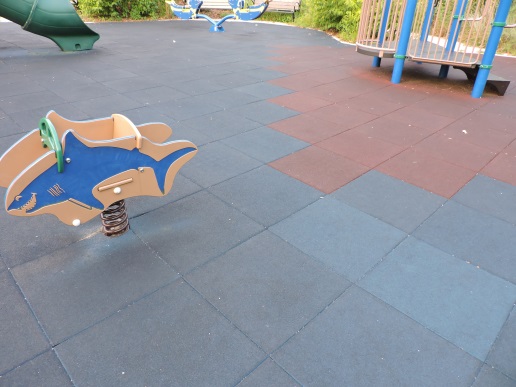
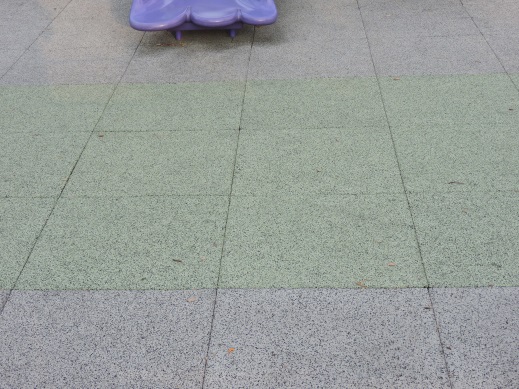
Appendix B. Playground Safety Guidance Signs and Warning Labels
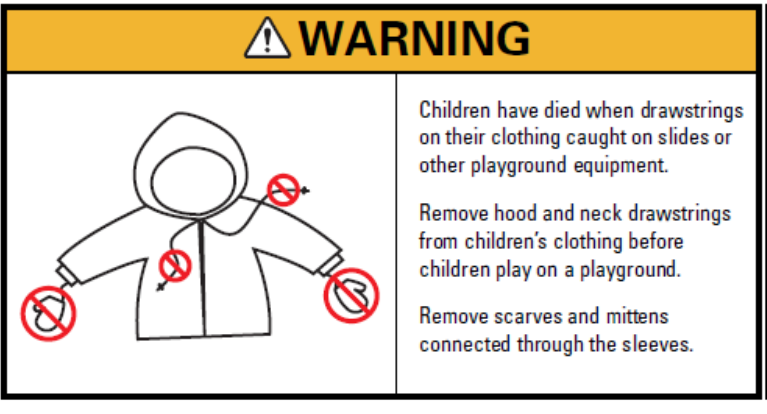

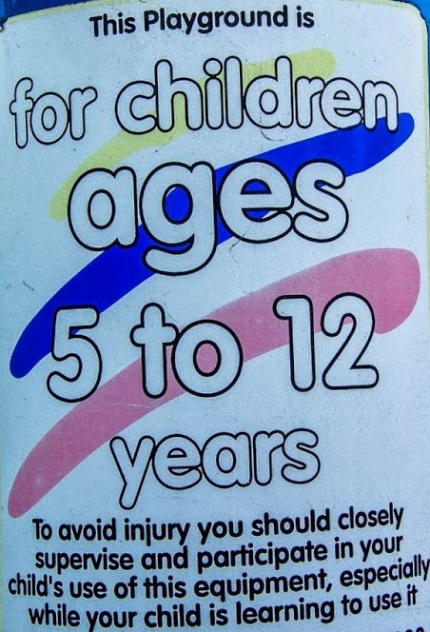
| File Type | application/vnd.openxmlformats-officedocument.wordprocessingml.document |
| File Title | DOCUMENTATION FOR THE GENERIC CLEARANCE |
| Author | 558022 |
| File Modified | 0000-00-00 |
| File Created | 2021-01-23 |
© 2025 OMB.report | Privacy Policy